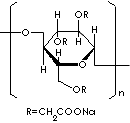CARBOXYMETHYL CELLULOSE SODIUM
PRODUCT IDENTIFICATION

H.S. CODE
Oral rat LD50: > 2000mg/kg
CLASSIFICATION
EXTRA NOTES
A cellulose derivative which is a Beta-(1->4)-D-glucopyranose polymer. It is used as a bulk laxative and as an emulsifier and thickener in cosmetics and pharmaceuticals and as a stabilizer for reagents.
Water-soluble polymer
PHYSICAL AND CHEMICAL PROPERTIES
free flowing white to off-white powder
AUTOIGNITION
> 300 C
NFPA RATINGS
REFRACTIVE INDEX
EXTERNAL LINKS & GENERAL DESCRIPTION
http://class.fst.ohio-state.edu/
SODIUM
CARBOXYMETHYL CELLULOSE Chemistry, Functionality, and Applications
http://cool.conservation-us.org/
This paper concerns the many uses of these two polymers in conservation.
Although this information is paper conservation oriented, it may very well be
that it can be useful to conservators in other fields.
Methylcellulose (MC) and sodium carboxymethylcellulose (sod. CMC) have many
other uses besides those in conservation. A brief rummage through your medicine
cabinet may come up with such products as toothpaste, laxatives, or diet pills
each of which may contain either MC or sod. CMC. Other products include ice
cream, water-based paints, detergents and a variety of paper products to name
but a few. Characteristics which make them useful are: high viscosity in low
concentrations, defoaming abilities, surfactant, and bulking abilities. They are
not toxic and do not promote allergic reactions in humans. At the end of this
paper, I have given more technical information on the composition of the various
MCs and sod. CMCs.
These cellulose polymers can be purchased in grades ranging from coarse to
fine particles and in varying viscosities. In solution, Hercules CMC 7H and
Culminal (MC from Talas) are quite clear while Cellofas B3500 from Conservation
Materials is hazy.
http://www.cosmeticsinfo.org/
Safety
Information: The Food and Drug Administration (FDA) includes Ethylcellulose,
Hydroxypropylcellulose, Methyl Ethylcellulose and Hydroxypropyl
Methylcellulose on its list of multipurpose additives allowed to
be directly added to food. FDA also permits Cellulose and a number
of modified cellulose polymers to be used as indirect food additives.
For example, Cellulose, Cellulose Acetate Butryate, Cellulose Acetate
Propionate, Cellulose Gum, Hydroxyethylcellulose, Hydroxyethyl Ethylcellulose,
Hydroxypropyl Methylcellulose and Methylcellulose can be used in
adhesives in contact with food. As substances migrating to food
from paper and paperboard products, FDA considers Cellulose Acetate
and Ethylcellulose to be Generally Recognized as Safe (GRAS). The
FDA has also approved the use of Cellulose Gum, Hydroxyethylcellulose,
Hydroxypropyl Methylcellulose and Methylcellulose for use as ophthalmic
demulcents in over-the-counter (OTC) drug products for the eyes.
When used in an OTC drug product Hydroxypropyl Methylcellulose must
be called Hypromellose. The safety of Cellulose, Calcium Carboxymethyl
Cellulose, Carboxymethyl Cellulose Acetate Butyrate, Carboxymethyl
Hydroxyethylcellulose, Cellulose Acetate, Cellulose Acetate Butyrate,
Cellulose Gum, Cellulose Acetate Propionate, Cellulose Acetate Propionate
Carboxylate, Cellulose Succinate, Cetyl Hydroxyethylcellulose, Ethylcellulose,
Hydrolyzed Cellulose Gum, Hydroxybutyl Methylcellulose, Hydroxyethylcellulose,
Hydroxyethyl Ethylcellulose, Hydroxypropylcellulose, Hydroxypropyl
Methylcellulose, Methylcellulose, Hydroxypropyl Methylcellulose
Acetate/Succinate, Methylcellulose, Methyl Ethylcellulose, Methyl
Hydroxyethylcellulose, Microcrystalline Cellulose, Potassium Cellulose
Succinate and Sodium Cellulose Sulfate has been assessed by the
Cosmetic Ingredient Review (CIR) Expert Panel. The CIR Expert Panel
evaluated the scientific data and concluded that these ingredients
were safe as cosmetic ingredients.
Local:
CMC
is used primarily in foods, drugs and
cosmetics as a viscosifier, emulsion stabilizer, thickener and to improve texture.
The main applications of technical grade are in textile warp sizing and
paper processing. CMC is also used in detergent as a antiredeposition agent, textile warp-sizing aid, adhesives, latex
paints and polishes.
DETERGENT APPLICATION
APPEARANCE
white to off-white powder
VISCOSITY
30cps max (1% sol.)
pH
5 - 9 (1% sol.)
MOISTURE
10.0% max
TRANSPORTATION